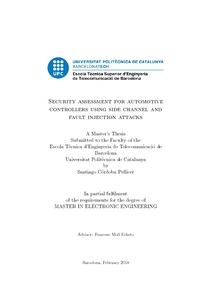Mostra el registre d'ítem simple
Security assessment for automotive controllers using side channel and fault injection attacks
| dc.contributor | Moll Echeto, Francisco de Borja |
| dc.contributor.author | Córdoba Pellicer, Santiago |
| dc.contributor.other | Universitat Politècnica de Catalunya. Departament d'Enginyeria Electrònica |
| dc.date.accessioned | 2018-06-01T11:50:23Z |
| dc.date.available | 2018-06-01T11:50:23Z |
| dc.date.issued | 2018-02 |
| dc.identifier.uri | http://hdl.handle.net/2117/117730 |
| dc.description | Embedded security is nowadays a hot topic. With the arrival of Internet of Things and the increasing presence of embedded electronics in automotive systems, security has become an important factor in product design. This work is aimed to test the security capabilities of automotive electronic devices, using physical attacks such as fault injection and other side-channel techniques. Modern integrated circuits implement countermeasures to such attacks, but it has been proven that those countermeasures were designed with safety in mind, as automotive applications usually requi |
| dc.description.abstract | Embedded security is nowadays a hot topic. With the arrival of Internet of Things and the increasing demand of connectivity for embedded systems in many industrial markets, including automotive systems, security has become an important factor in product design. This thesis is aimed to test the security capabilities of automotive electronic devices, using physical attacks known as fault injection. Although other industries have been using countermeasures against physical attacks for decades, these are rarely used in automotive embedded systems. Automotive industry efforts have been focused in improving safety and reliability (e.g. ISO 26262 ASIL certification) instead of security. Previous research proved the risk of fault injection attacks on automotive SoCs, but these works were limited to small testing applications running on evaluation boards and not real automotive systems. The current work aims to assess the security of off-the-shelf automotive systems running real applications. More specifically, fault injection attacks are used to bypass the authentication mechanism of the Unified Diagnostic System (ISO 14229) present in two different commercial car dashboards. The findings are exposed in order to suggest design improvements and recommendations for a more secure automotive embedded systems and SoCs. |
| dc.language.iso | eng |
| dc.publisher | Universitat Politècnica de Catalunya |
| dc.rights | S'autoritza la difusió de l'obra mitjançant la llicència Creative Commons o similar 'Reconeixement-NoComercial- SenseObraDerivada' |
| dc.rights.uri | http://creativecommons.org/licenses/by-nc-nd/3.0/es/ |
| dc.subject | Àrees temàtiques de la UPC::Enginyeria electrònica |
| dc.subject.lcsh | Automobiles -- Electronic equipment |
| dc.subject.other | Fault injection |
| dc.subject.other | automotive |
| dc.subject.other | ECU |
| dc.subject.other | UDS |
| dc.subject.other | ISO 14229 |
| dc.subject.other | Security |
| dc.title | Security assessment for automotive controllers using side channel and fault injection attacks |
| dc.type | Master thesis |
| dc.subject.lemac | Automòbils -- Equip electrònic |
| dc.identifier.slug | ETSETB-230.133239 |
| dc.rights.access | Open Access |
| dc.date.updated | 2018-02-14T06:51:21Z |
| dc.audience.educationlevel | Màster |
| dc.audience.mediator | Escola Tècnica Superior d'Enginyeria de Telecomunicació de Barcelona |


